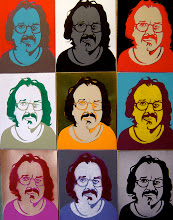 (I figured out recently that if you click on the picture you can get a larger version of it. If you click on the enlargement, you get a good close up that will let you see the texture of the surface and the details of the painting.)
(I figured out recently that if you click on the picture you can get a larger version of it. If you click on the enlargement, you get a good close up that will let you see the texture of the surface and the details of the painting.)
Monday, August 10
Here come the roosters! I love roosters. When I was living in Honduras they were everywhere and not a day went by that I didn’t actively admire them.
“Damn,” I’d say to myself or to Deb. “There’s a handsome bastard,” meaning I’d just spotted a rooster with dramatically shaped plumage, an eye catching comb, intimidating spurs, and a combination of iridescent colors that took my breath away. Some of these guys stood knee high to me. Occasionally, I’d run across an aggressive one, but usually they gave their full attention to scratching and pecking and doing the other thing roosters do. Only a few had the time to spare to charge a gringo.
I saw a rooster
with feathers of Spanish
luster:
black and white cloth
was the stuff
of its shirt,
knee britches,
and arching tail feathers.
its feet sheathed
in yellow boots
displayed the sheen of defiant
spurs.
The
proud
head
crowned
with blood
intensified
its scornful stance:
a statue
of pride.
I love Neruda’s “Ode to a Rooster”, but my perception of roosters is very different from his. The cock he anthropomorphizes so eloquently is a regal character, a kind of benign monarch or the barnyard. Neruda describes him finding a crumb of bread which he passes on to his hens, “keeping nothing for himself / but pride...”
I’ve observed a lot of rooster behavior and I’ve seen nothing that I’d describe as generous or even unselfish. In fact everything in a rooster’s behavioral repertoire seems to have to do with satisfying a limited number of biological imperatives: scratch, peck, scratch, peck, jump a chicken, scratch, peck, scratch, peck, jump a chicken.
Oh yeah, and crow. I don’t know what the biological imperative behind crowing is, but I’m sure there is one.
Remember learning that roosters crow at dawn? Forget it. They crow any damn time they feel like it. However, at dawn they crow in unison, every one in town and there are hundreds, thousands.
Interestingly, in the US, when roosters crow, they say cock-a-doodle-do, but in Latin America they say ki-ki-riki-ki.
Here’s Neruda on rooster sex:
swift movement
of love, ravishment
of feathered shadows,
I praise you,
black
and white
rooster,
strutting
sum
of virile rural honor,
father
of the fragile, egg…
He got the “swift”, “ravishment” and “strutting” right. The rooster jumps on the hens back, pens her head into the dirt, flaps his wings wildly three or four times, and he’s done. The hen gets up, shakes herself off, and goes back to scratching and pecking. The father of the fragile egg struts around bragging about what he’s just done. I know. I am anthropomorphizing, too, just like Neruda, but you watch a rooster right after he’s jumped a hen and tell me that he not thinking, “Yeah, baby! That’s what I’m talking about. I gave it to her good! Call me the love machine.”
Maybe roosters are viewed differently in every epoch. Writing in the fifties, Neruda described a dignified, benevolent, patriarch, a kind of pre-feminist cock. I’m a sixties/seventies/eighties kind of guy. I think about equality, self-determination, and empowerment for the hen. And yet I love roosters and think they are beautiful. Maybe my rooster admiration is post-feminist.

No comments:
Post a Comment